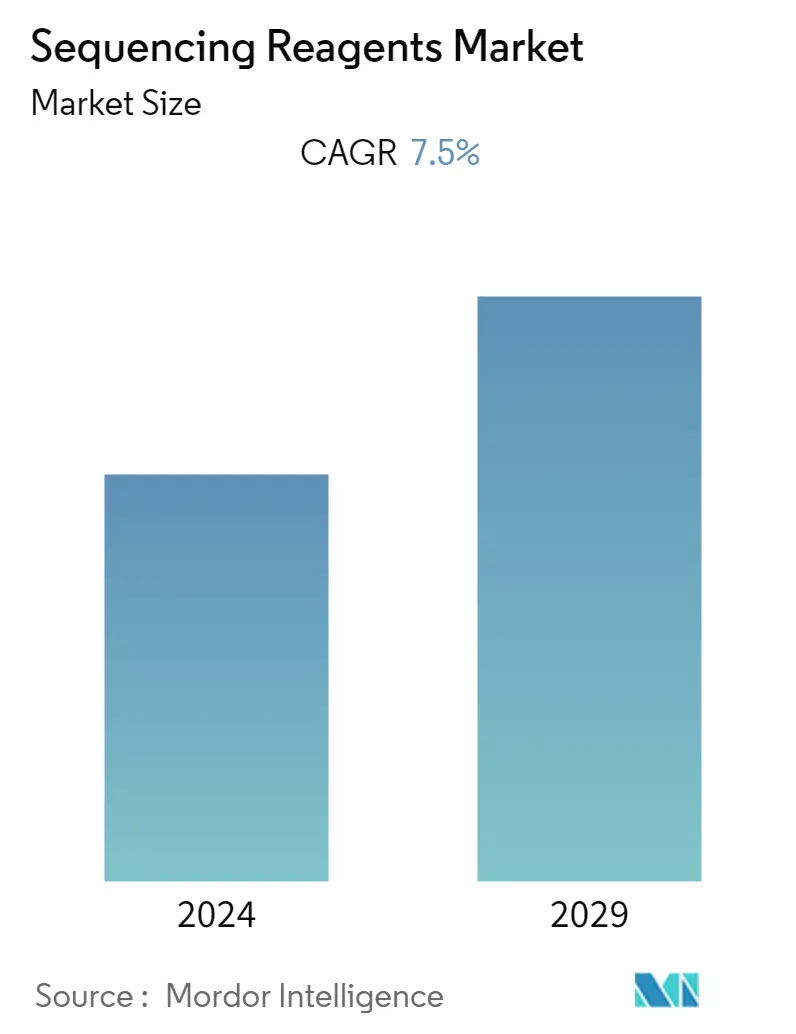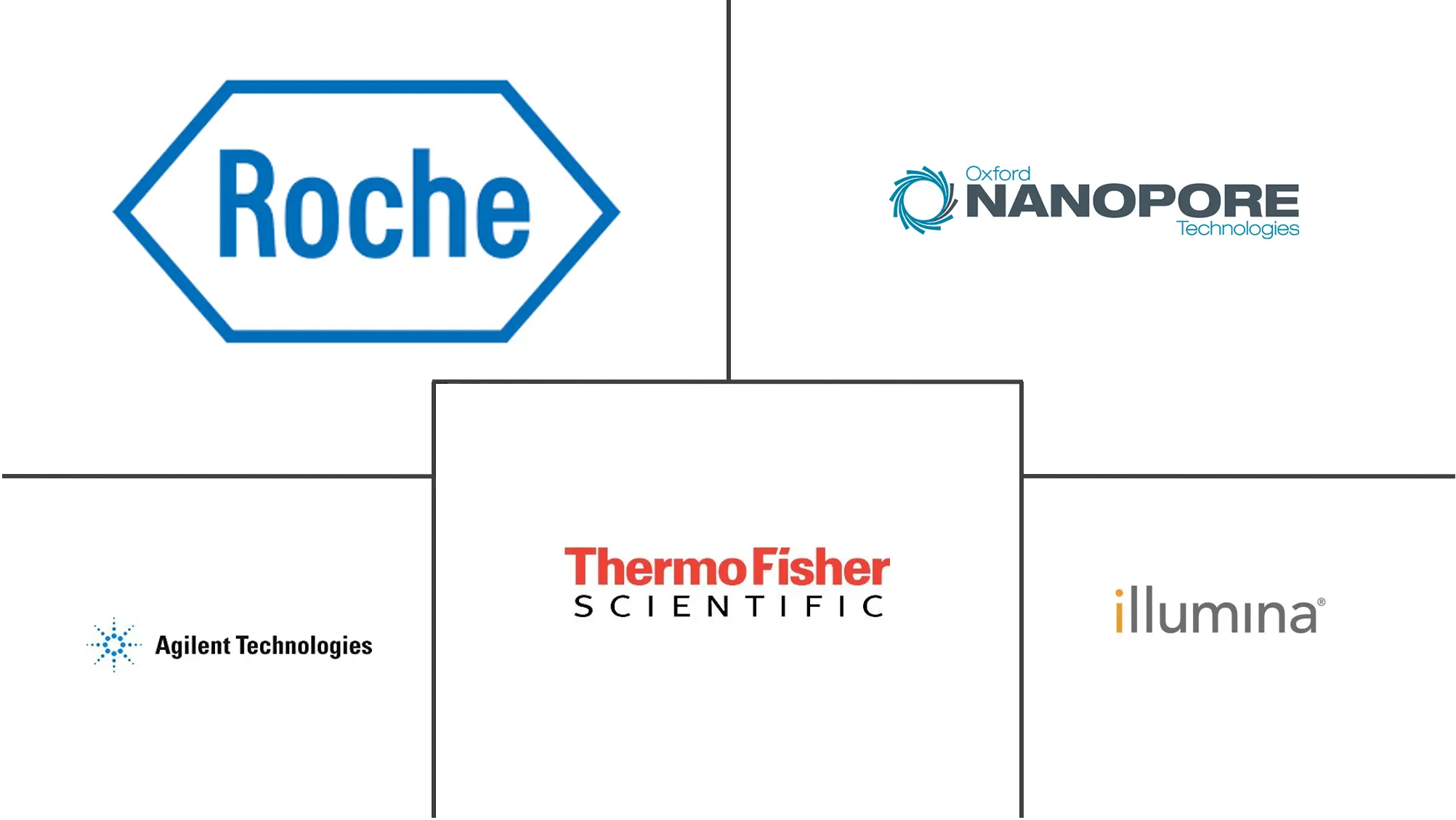Market Size of Sequencing Reagents Industry

| Study Period | 2019 - 2029 |
| Base Year For Estimation | 2023 |
| Forecast Data Period | 2024 - 2029 |
| CAGR | 7.50 % |
| Fastest Growing Market | Asia Pacific |
| Largest Market | North America |
Major Players
*Disclaimer: Major Players sorted in no particular order |
Sequencing Reagents Market Analysis
The Sequencing Reagents Market is expected to register a CAGR of 7.5% during the forecast period. This is attributing to increasing demand for third-generation sequencing, decreasing costs for genetic sequencing, and increasing R&D expenditure on genomic research. In addition, developments in sequencing technologies to provide high yield data for large scale genomic research and availability of new commercial reagents kits for specific sequencing technologies will also promote the growth of the sequencing reagents market. Nanopore and single-molecule real-time sequencing are some of the novel technologies, with its cost-effective and efficient preparation of sequencing the DNA results in adoption by researchers to sequence the genome in a short time and less cost. Moreover, the cost of genetic sequencing has been falling from USD 10-15 million per genome in 2001 to USD 1,200 per genome in 2017. Thus, the declining cost of genetic sequencing will boost the growth sequencing technologies, and which further drive the use of sequencing reagents. Furthermore, favorable government initiatives and increasing funding of private and public entities will also trigger the growth of sequencing technologies and propel the demand for sequencing reagents in the forecasted period.
Sequencing Reagents Industry Segmentation
As per the scope, sequencing reagents are used in the process of DNA sequencing, an important tool to determine the order of nucleotides. DNA sequencing has several types of research, the diagnostic and therapeutic application includes drug discovery, forensics, genomics, cancers, infectious disease, and many more.
| By Type | |
| Template Kits | |
| Library Kits | |
| Control Kits | |
| Sequencing Kits | |
| Others |
| By Technology | |
| Next Generation Sequencing | |
| Sanger Sequencing | |
| Third Generation Sequencing |
| By Application | |
| Clinical Investigation | |
| Oncology | |
| Forensics & Agrigenomics | |
| Others |
| Geography | ||||||||
| ||||||||
| ||||||||
| ||||||||
| ||||||||
|
Sequencing Reagents Market Size Summary
The Sequencing Reagents Market is poised for significant growth, driven by the increasing demand for advanced sequencing technologies and the decreasing costs associated with genetic sequencing. The market is experiencing a surge in interest due to innovations in sequencing technologies that offer high-yield data for extensive genomic research. The introduction of new commercial reagent kits tailored for specific sequencing technologies is further propelling market expansion. Novel approaches such as nanopore and single-molecule real-time sequencing are gaining traction for their cost-effective and efficient DNA preparation capabilities, enabling researchers to conduct genome sequencing more rapidly and economically. The declining costs of genetic sequencing, coupled with supportive government initiatives and increased funding from both private and public sectors, are expected to further stimulate the market's growth during the forecast period.
Next-generation sequencing (NGS) is anticipated to experience robust growth, fueled by its expanding applications in molecular pathology, diagnostics, and clinical research. The comprehensive and deep sequencing capabilities of NGS facilitate quicker identification of conditions and the discovery of novel or rare variants, enhancing its appeal in personalized medicine and companion diagnostics. The rising expenditure in biopharmaceutical research and development is also contributing to the market's expansion. North America is projected to maintain a substantial market share, supported by the prevalence of chronic diseases, a strong presence of pharmaceutical companies, and significant R&D investments. The region's well-established infrastructure and increasing healthcare expenditure are expected to further drive market growth. The Sequencing Reagents Market is moderately competitive, with key players such as F. Hoffmann-La Roche AG, Illumina, Inc., and Thermo Fisher Scientific leading the industry.
Sequencing Reagents Market Size - Table of Contents
-
1. MARKET DYNAMICS
-
1.1 Market Overview
-
1.2 Market Drivers
-
1.2.1 Increasing Demand for Third Generation Sequencing
-
1.2.2 Decreasing Costs for Genetic Sequencing
-
1.2.3 Increasing R&D Expenditure
-
-
1.3 Market Restraints
-
1.3.1 Limited Reimbursement Policy and Regulation for NGS
-
1.3.2 Ethical and Social Issues Associated with Sequencing
-
-
1.4 Porter's Five Force Analysis
-
1.4.1 Threat of New Entrants
-
1.4.2 Bargaining Power of Buyers/Consumers
-
1.4.3 Bargaining Power of Suppliers
-
1.4.4 Threat of Substitute Products
-
1.4.5 Intensity of Competitive Rivalry
-
-
-
2. MARKET SEGMENTATION
-
2.1 By Type
-
2.1.1 Template Kits
-
2.1.2 Library Kits
-
2.1.3 Control Kits
-
2.1.4 Sequencing Kits
-
2.1.5 Others
-
-
2.2 By Technology
-
2.2.1 Next Generation Sequencing
-
2.2.2 Sanger Sequencing
-
2.2.3 Third Generation Sequencing
-
-
2.3 By Application
-
2.3.1 Clinical Investigation
-
2.3.2 Oncology
-
2.3.3 Forensics & Agrigenomics
-
2.3.4 Others
-
-
2.4 Geography
-
2.4.1 North America
-
2.4.1.1 United States
-
2.4.1.2 Canada
-
2.4.1.3 Mexico
-
-
2.4.2 Europe
-
2.4.2.1 Germany
-
2.4.2.2 United Kingdom
-
2.4.2.3 France
-
2.4.2.4 Italy
-
2.4.2.5 Spain
-
2.4.2.6 Rest of Europe
-
-
2.4.3 Asia-Pacific
-
2.4.3.1 China
-
2.4.3.2 Japan
-
2.4.3.3 India
-
2.4.3.4 Australia
-
2.4.3.5 South Korea
-
2.4.3.6 Rest of Asia-Pacific
-
-
2.4.4 Middle-East and Africa
-
2.4.4.1 GCC
-
2.4.4.2 South Africa
-
2.4.4.3 Rest of Middle-East and Africa
-
-
2.4.5 South America
-
2.4.5.1 Brazil
-
2.4.5.2 Argentina
-
2.4.5.3 Rest of South America
-
-
-
Sequencing Reagents Market Size FAQs
What is the current Sequencing Reagents Market size?
The Sequencing Reagents Market is projected to register a CAGR of 7.5% during the forecast period (2024-2029)
Who are the key players in Sequencing Reagents Market?
F. Hoffmann-La Roche AG, Illumina, Inc, Thermo Fisher Scientific, Oxford Nanopore Technologies and Agilent Technologies, Inc. are the major companies operating in the Sequencing Reagents Market.

